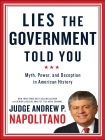Lies the government told you by Andrew Napolitano (best e reader for epub TXT) 📗

- Author: Andrew Napolitano
Book online «Lies the government told you by Andrew Napolitano (best e reader for epub TXT) 📗». Author Andrew Napolitano
Finally, rather than following well-established securities law, where secured creditors and bondholders get paid first when a corporation liquidates, the government paid out the United Auto Workers union, an unsecured creditor meant to get paid last in a bankruptcy. Instead, the union got almost double the amount of what the secured creditors did. Of course, the government continues to placate the public with assurances of the temporary nature of the fix and how GM will soon become profitable again.
So there it is; the government has acquired yet another corporation that it thinks it will be able to run more successfully than the private sector did. Of course, nationalizing an automobile maker sounds very much like something from Communist Russia, or Socialist Venezuela; and we know how successful those governments have been at earning profits. So now our government has spent billions of dollars of taxpayer money so that it can keep open a company, General Motors, that the market was on the brink of closing. And, if the history of Amtrak and the Post Office has anything to say, the government will continue to pour billions into GM well into the next century, without a thought for profit but always with the justifications of employment and public welfare.
Reagan once said that “[g]overnment’s view of the economy could be summed up in a few short phrases: If it moves, tax it. If it keeps moving, regulate it. And if it stops moving, subsidize it.” Well, the government has just done that with General Motors, because it will never be able to run it profitably, so instead it will just keep pumping taxpayer money into it.
Government Railroad
The story of Amtrak begins in 1971 during the Nixon Administration, as it was then that Congress established Amtrak as a federally owned passenger railroad. Originally, the government claimed that such a passenger railroad was important and also claimed that it expected “the corporation would experience financial losses for three years and then become a self-sustaining enterprise.”17 Well, it has now been forty years, and Amtrak has yet to make a profit. Instead, it has survived on government subsidies, grants, and loans of enormous proportions, totaling over $25 billion throughout its existence.18
At the same time, while airline travel has increased from 191.3 million passengers in 1972 to 665.6 million in 2000, Amtrak passengers went from 16.6 million in 1972 to 22.5 million in 2000.19 This increase of 6 million passengers, considering the intense population growth in the U.S. during that time, exhibits the minimal need for train travel, and the fact that if there were a demand for such travel, the private market could handle it more efficiently. And if it could not, Amtrak would have been closed many years ago.
Privatization in other countries has illustrated that the private industry is much more efficient than anything the public sector can do. For example, privately owned Virgin Rail took over publicly owned British Rail and sparked such a traffic boom that the company has now placed an order for $3 billion in new trains.20 While Amtrak’s survival depends not on its ability to generate profits but solely on political hay, it will keep losing money and costing billions of dollars. The government has given multiple deadlines for Amtrak to reach profitability or face closure, and such deadlines have never been met, yet Amtrak continues its operations.21
One could argue that Amtrak, rather than an illustration of government inefficiency, is an illustration of the lack of demand for rail transport. For those there is the example of the United States Postal Service (USPS). Currently the USPS is facing extraordinary deficits. From January to July 2009, the USPS lost over $7 billion, and the government is attempting to figure out a resolution, including stopping Saturday delivery.22
Because the government consumes wealth, rather than produces wealth, the government can only save money by shutting down (so as to stop the consumption). In this respect (consumption versus production) the government and private enterprise are literally opposites. When private enterprise wants more income, it works overtime and produces more goods. When the government wants to save money, as the government of the City of Chicago did for a few days in the summer of 2009, it shuts down.
The Father of the Three-Cent Stamp
For some reason, we have become so indoctrinated to the need for a government-run monopoly on mail delivery that many have forgotten the story of Lysander Spooner. Though not many today know the name, he was a lawyer and author of The Unconstitutionality of Slavery, which was cited by Supreme Court Justice Antonin Scalia in his opinion in District of Columbia v. Heller. Another of his achievements was his establishment of the American Mail Company in 1844, a challenge to the monopoly of the Post Office, which was charging exorbitant rates.
By early 1843, mail prices had soared, and the government charged nearly nineteen cents to deliver a letter from Boston to New York.23 In setting up his company, Spooner set up service to run between New York, Boston, Philadelphia, and Baltimore, which were also some of the main Post Office routes. He then announced that he would be charging a little over six cents per half-ounce letter and that there would be daily delivery in the cities. Initially, the government ignored his new company, but soon it was losing customers to the American Letter Mail Company.
Because of the competition from his business, the government filed suit to have him barred from invading the postal





Comments (0)